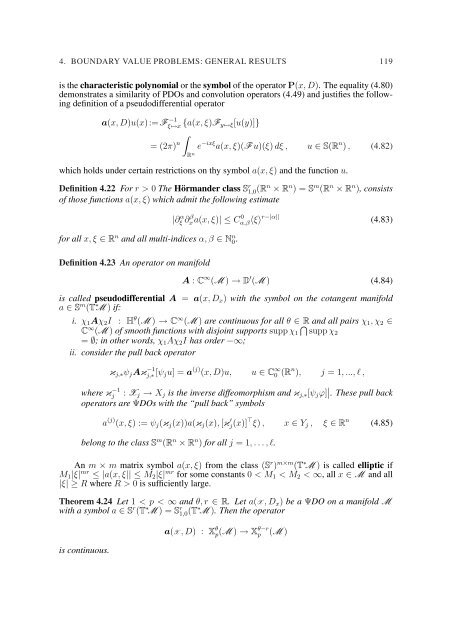EQUATIONS OF ELASTIC HYPERSURFACES
EQUATIONS OF ELASTIC HYPERSURFACES
EQUATIONS OF ELASTIC HYPERSURFACES
You also want an ePaper? Increase the reach of your titles
YUMPU automatically turns print PDFs into web optimized ePapers that Google loves.
4. BOUNDARY VALUE PROBLEMS: GENERAL RESULTS 119<br />
is the characteristic polynomial or the symbol of the operator P(x, D). The equality (4.80)<br />
demonstrates a similarity of PDOs and convolution operators (4.49) and justifies the following<br />
definition of a pseudodifferential operator<br />
a(x, D)u(x):=F −1<br />
ξ↦→x {a(x, ξ)F y↦→ξ[u(y)]}<br />
= (2π) n ∫R n e −ixξ a(x, ξ)(F u)(ξ) dξ , u ∈ S(R n ) , (4.82)<br />
which holds under certain restrictions on thy symbol a(x, ξ) and the function u.<br />
Definition 4.22 For r > 0 The Hörmander class S r 1,0(R n × R n ) = S m (R n × R n ), consists<br />
of those functions a(x, ξ) which admit the following estimate<br />
for all x, ξ ∈ R n and all multi-indices α, β ∈ N n 0.<br />
Definition 4.23 An operator on manifold<br />
|∂ α ξ ∂ β x a(x, ξ)| ≤ C 0 α,β〈ξ〉 r−|α|| (4.83)<br />
A : C ∞ (M ) → D ′ (M ) (4.84)<br />
is called pseudodifferential A = a(x, D x ) with the symbol on the cotangent manifold<br />
a ∈ S m (T ∗ M ) if:<br />
i. χ 1 Aχ 2 I : H θ (M ) → C ∞ (M ) are continuous for all θ ∈ R and all pairs χ 1 , χ 2 ∈<br />
C ∞ (M ) of smooth functions with disjoint supports supp χ 1<br />
⋂ supp χ2<br />
= ∅; in other words, χ 1 Aχ 2 I has order −∞;<br />
ii. consider the pull back operator<br />
κ j,∗ ψ j Aκ −1<br />
j,∗ [ψ ju] = a (j) (x, D)u, u ∈ C ∞ 0 (R n ), j = 1, ..., l ,<br />
where κ −1<br />
j : X j → X j is the inverse diffeomorphism and κ j,∗ [ψ j ϕ] ∣ . These pull back<br />
operators are ΨDOs with the “pull back” symbols<br />
a (j) (x, ξ) := ψ j (κ j (x))a(κ j (x), [κ ′ j(x)] ⊤ ξ) , x ∈ Y j , ξ ∈ R n (4.85)<br />
belong to the class S m (R n × R n ) for all j = 1, . . . , l.<br />
An m × m matrix symbol a(x, ξ) from the class (S r ) m×m (T ∗ M ) is called elliptic if<br />
M 1 |ξ| mr ≤ |a(x, ξ|| ≤ M 2 |ξ| mr for some constants 0 < M 1 < M 2 < ∞, all x ∈ M and all<br />
|ξ| ≥ R where R > 0 is sufficiently large.<br />
Theorem 4.24 Let 1 < p < ∞ and θ, r ∈ R. Let a(X , D x ) be a ΨDO on a manifold M<br />
with a symbol a ∈ S r (T ∗ M ) = S r 1,0(T ∗ M ). Then the operator<br />
is continuous.<br />
a(X , D) : X θ p(M ) → X θ−r<br />
p (M )

















